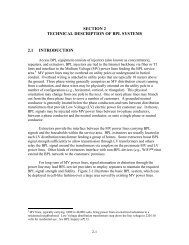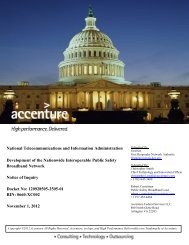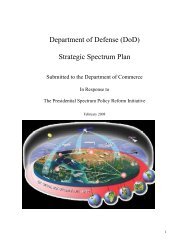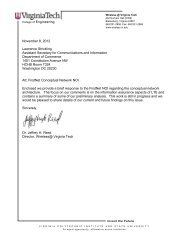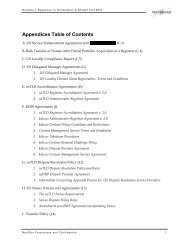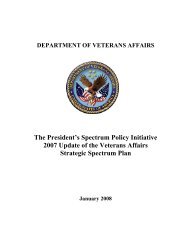NTIA State Planning RFI Response Final - National ...
NTIA State Planning RFI Response Final - National ...
NTIA State Planning RFI Response Final - National ...
Create successful ePaper yourself
Turn your PDF publications into a flip-book with our unique Google optimized e-Paper software.
United <strong>State</strong>s Department of Commerce<br />
<strong>National</strong> Telecommunications and Information Administration<br />
Regarding the: ) Docket: 120509050-1050-01<br />
)<br />
Development of the <strong>State</strong> and Local )<br />
Implementation Grant Program for the )<br />
Nationwide Public Safety Broadband Network )<br />
)<br />
Request for Information )<br />
Comments from the <strong>State</strong> of Colorado Governor’s Office of<br />
Information Technology (“OIT”)<br />
I. Introduction<br />
The <strong>State</strong> of Colorado Governor’s Office of Information Technology (“OIT”) is<br />
pleased to submit our comments regarding the implementation of the <strong>State</strong><br />
and Local Implementation Grant Program (“Program”) as outlined in the<br />
Request for Information (“<strong>RFI</strong>”) posted in the Federal Register Vol. 77, No.<br />
95/Wednesday May 16, 2012. We appreciate the opportunity to provide<br />
feedback to this important program and look forward to working with the<br />
<strong>NTIA</strong>.<br />
Please note that additional comments were filed separately by Kristin Russell,<br />
the CIO for the <strong>State</strong> of Colorado. These comments addressed questions 2<br />
and 16. Please reference those comments for additional information.<br />
II.<br />
Comments<br />
Question 1: Consultation with FirstNet<br />
OIT <strong>Response</strong><br />
OIT believes the collection of relevant data should be a primary goal of the<br />
planning process as the efficient utilization of local resources will be critical to<br />
the success of the Public Safety Broadband Network (“PSBN”). We believe<br />
the following are some of the crucial data that should be collected.
• Available Towers<br />
o Location, AGL, ownership, current loading, backhaul capability,<br />
current use, hardening<br />
• Existing Fiber Infrastructure<br />
o Location, ownership, capacity, current use<br />
• Existing Microwave Infrastructure<br />
o Location, capacity, frequency<br />
• Potential network users<br />
o First Responders (Fire, Law enforcement, EMS)<br />
o Secondary Responders (Public Works, Transportation, utilities,<br />
etc.)<br />
• Potential Grade of Service frameworks based on the specific<br />
population, roadway and travel patterns within the state (e.g., urban,<br />
rural, suburban, destination centers)<br />
As mentioned, OIT believes these activities are central to the overall goal of<br />
the planning grants and therefore should be funded by the Program. These<br />
tasks will take significant effort in both human and capital resources.<br />
Additionally, OIT believes FirstNet should establish a standard classification<br />
mechanism for the assets to provide guidance to local entities on the type and<br />
format of information desired.<br />
Question 4: Existing Governance Structures<br />
OIT <strong>Response</strong><br />
While the current governance structures have been and continue to be critical<br />
for existing public safety communication systems, OIT believes a<br />
comprehensive review of governance is necessary to ensure success in the<br />
development and implementation of the PSBN. The technologies and<br />
business model that will be utilized moving forward are vastly different and<br />
provide an opportunity to revisit the governance structures in place. The<br />
effects of the PSBN will be felt across not just public safety but all public<br />
services and therefore require a comprehensive governance solution. The<br />
existing SWIC and SIEC models may work well in specific states but just as<br />
each state is unique in its service delivery methodology, the appropriate<br />
governance structures may differ as well. Additionally, one of the core<br />
requirements of the planning process is to engage the local communities and<br />
tribes, and performing this review will provide an excellent opportunity to
engage these communities. In addition to the aforementioned organizations,<br />
Colorado has developed a variety of regionalized efforts including:<br />
• All Hazard Regions: These groups are designed to bring together<br />
regionalized public safety interests throughout the state to plan and<br />
coordinate activities such as emergency preparedness, DHS grants<br />
and other first responder activities.<br />
• Local Technology <strong>Planning</strong> Teams: This effort is focused on local<br />
communities and bringing together the public and private interests<br />
within those communities to address broadband technology needs.<br />
OIT believes that using all of these resources to engage communities<br />
throughout the state will allow us to identify the proper governance structure<br />
for the PSBN within Colorado.<br />
Regarding the <strong>State</strong>wide Communications Interoperability Plan (“SCIP”), OIT<br />
believes the PSBN should be integrated into the plan as it will become a<br />
primary communications medium for both day-to-day and incident based first<br />
responder communications. We believe any costs associated with modifying<br />
the document should be allowable under the Program.<br />
Question 5: Leveraging Existing Infrastructure<br />
OIT <strong>Response</strong><br />
As mentioned, OIT believes leveraging existing infrastructure will be crucial to<br />
the success of the PSBN. In Colorado, as in many states, the state, counties,<br />
municipalities and tribes will separately own these assets. Once identified,<br />
significant effort will be required to coordinate and organize the assets so they<br />
may be made available to FirstNet. OIT believes the Program should cover<br />
the costs for determining how these assets are made available. With a<br />
variety of local and state laws regarding ownership, usage and revenue<br />
generation, Colorado will have to work with all stakeholders to ensure there is<br />
consistency in how these assets are made available.<br />
In determining suitability, OIT believes FirstNet will need to establish some<br />
standards for the desired assets based on potential usage and specific<br />
architecture. As one of the states with early LTE implementation (Adams<br />
County Communications Center), Colorado has developed an understanding<br />
of the LTE technology and already begun work on creating the collaborations<br />
necessary to plan the statewide network. Colorado possesses a number of
technical personnel both at the state and local level that understand the<br />
technology requirements and can help develop a solid plan for network<br />
development. Possessing these resources will be beneficial as Colorado can<br />
assist FirstNet in determining the suitability of specific infrastructure for the<br />
NSPBN. OIT believes the process for determining suitability will be a<br />
collaborative process not only within a state, but also between the states and<br />
FirstNet.<br />
In the rural sections of Colorado, local utility cooperatives play a key role in<br />
infrastructure. Through some of the previously mentioned outreach<br />
structures, Colorado has already begun the process of engaging rural utility<br />
cooperatives in regards to broadband infrastructure. Many of these utilities<br />
are working with BTOP, RUS and other federal programs to make<br />
infrastructure available to those who have a need. For example, local<br />
cooperatives have allowed fiber-optic cable to be placed on their existing<br />
infrastructure and/or provided access to existing fiber. OIT feels these<br />
established relationships will be valuable in determining the overall inventory<br />
within the state of Colorado.<br />
OIT believes the potential for public-private partnerships is great within the<br />
PSBN and would welcome the opportunity to explore such options; however,<br />
OIT believes the structure and implementation of these partnerships should<br />
be left up to the states and their local entities to develop.<br />
Question 6: Integration of Resources into the RFP Process<br />
OIT <strong>Response</strong><br />
The mechanism utilized for access to its assets will be unique to each state.<br />
Local, state or tribal laws may prohibit or directly specify certain methods.<br />
OIT believes the <strong>NTIA</strong> should allow funding for Colorado to develop a<br />
methodology and structure for this process. We believe the <strong>NTIA</strong> should<br />
publish general specifications/goals for the interaction between RFP<br />
respondents and states in order to allow states to develop the best structure<br />
that works within their laws and environments. We understand and agree that<br />
a single “clearinghouse” would be the most efficient model, however, the<br />
specific interests and rights (legal, financial, etc.) of the asset owner must be<br />
maintained and integrated into any contract.
Questions 8 and 9: Allowable Expenses<br />
OIT <strong>Response</strong><br />
OIT believes a broad range of expenses and activities that are specifically<br />
tied to the identified goals of the Program should be allowed. These may<br />
include, but are not limited to:<br />
• Developing a statewide inventory of assets<br />
• Creating necessary governance and clearinghouse structures<br />
• Financial analysis of asset values and future costs<br />
• General LTE training<br />
• Personnel costs (new and existing)<br />
• Travel (mileage, lodging, meals)<br />
• Hardware and software related to the process (Inventory software,<br />
computers, GPS devices, etc)<br />
• Collaboration/coordination costs (meetings/events/education)<br />
• Data gathering or procurement of necessary data sets<br />
• Contractors that perform tasks associated with the planning activities<br />
Question 12: SBI Related Activities<br />
OIT <strong>Response</strong><br />
It is critical for the <strong>State</strong>s’ SBI designated entities to be included in this<br />
Program. These entities have been developing information on broadband<br />
availability and, in some cases, available broadband infrastructure. They have<br />
developed the capacity and organizational network to expand the information<br />
gathering to the necessary elements, many of which are identified in our<br />
response to Question 1, for planning for the PSBN. Some issues may arise,<br />
however, that will warrant specific attention or action from the <strong>NTIA</strong>.<br />
• In states where the SBI designated entity is not a state entity, the<br />
integration of the SBI data may be more difficult. Some of the<br />
contractual arrangements between these third party entities and states<br />
do not provide the necessary transparency into the mapping process<br />
or access to the raw mapping data. If possible, within the confines of<br />
state contractual rules, the <strong>NTIA</strong> should require third party designated<br />
entities to share necessary data with states for the FirstNet
implementation planning. The designated entities for this planning<br />
should be an entity within state government. In Colorado, we<br />
deliberately structured our broadband data and development program<br />
to allow for this transparency and transfer of data, and we<br />
subsequently moved the program entirely to internal state staff, so we<br />
are well positioned to integrate with the implementation planning.<br />
• Much of the information required for the FirstNet implementation<br />
planning relates to infrastructure. This information has been difficult to<br />
obtain from broadband service providers and can even be difficult to<br />
collect from other state agencies at times. The reason for the latter<br />
issue often relates to independent funding sources from federal<br />
agencies that promote single use within the specific state government<br />
agency. The <strong>NTIA</strong> can assist by working with federal agencies to ease<br />
previous requirements for single use and/or requiring future grants to<br />
share information for this purpose.<br />
Respectfully submitted,<br />
Governor’s Office of Information Technology<br />
<strong>State</strong> of Colorado





